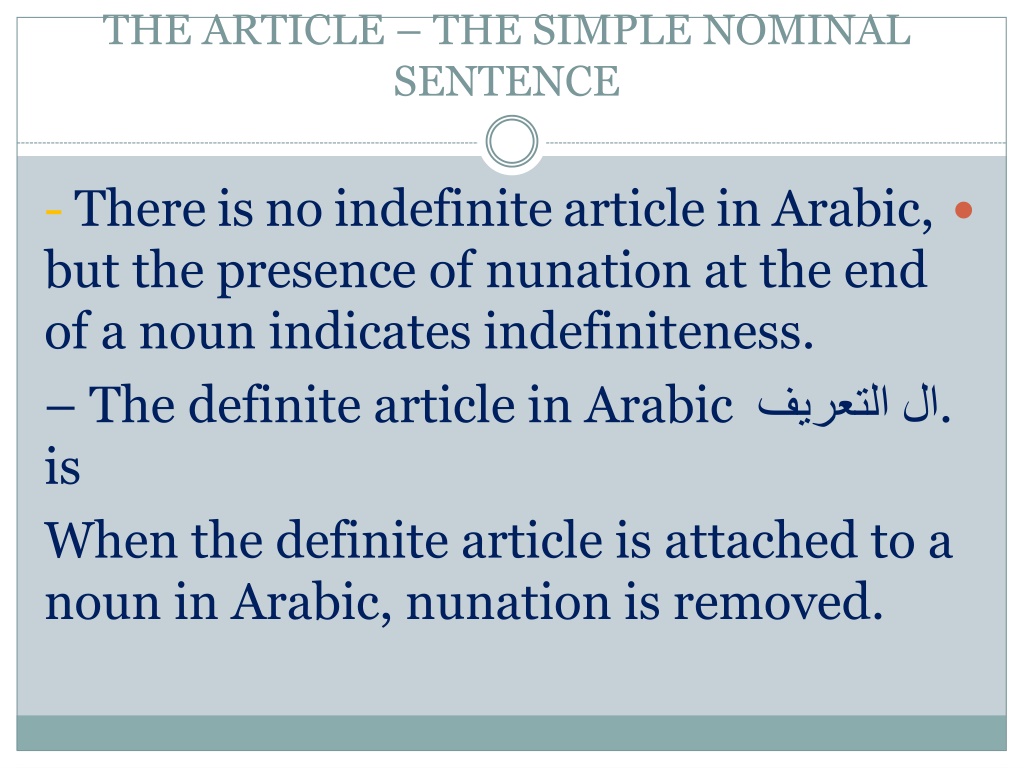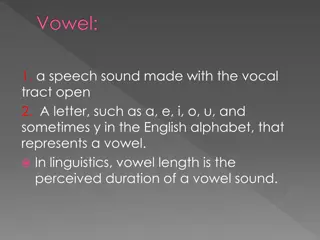Understanding Arabic Grammar and Gender Rules
Arabic grammar rules include the use of definite and indefinite articles, placement of adjectives, and singular personal pronouns. Gender in Arabic is limited to masculine and feminine, with specific categories determining the gender of words. Learn more about these language features in Arabic.
Download Presentation

Please find below an Image/Link to download the presentation.
The content on the website is provided AS IS for your information and personal use only. It may not be sold, licensed, or shared on other websites without obtaining consent from the author. Download presentation by click this link. If you encounter any issues during the download, it is possible that the publisher has removed the file from their server.
E N D
Presentation Transcript
THE ARTICLE THE SIMPLE NOMINAL SENTENCE - There is no indefinite article in Arabic, but the presence of nunation at the end of a noun indicates indefiniteness. The definite article in Arabic is When the definite article is attached to a noun in Arabic, nunation is removed. .
-The hamza in the definite article is This disappears when it follows another word. In pronunciation, the sound I immediately follows the final sound in the preceding word. -When the definite article is attached to a noun that begins with certain letters called sun-letters, the I of the definite article changes into the initial letter of the word. These letters are : - - .
-Adjectives are placed after the nouns they qualify in the Arabic language. The adjectives agrees with the noun it modifies with regards to definiteness and indefiniteness among other things, such as number and gender.
-When two or more adjectives modify the same noun it is not necessary to put and between them. However, if the two adjectives form the predicate of a nominal sentence, and is inserted between them.
-The singular personal pronouns in Arabic are : I You (masculine) You (feminine) he/it She/it -The pronouns for he and she in Arabic are both used to refer to things (i.e., it) since there is no neuter in Arabic.
GENDER 1- There are only two genders in Arabic, masculine and feminine. There is no neuter in Arabic. 2- There is no special sign for the masculine. Words are assumed to be masculine unless they belong to one of the following categories :
A- Words that are feminine by virtue of their meaning. B- Words that are feminine by form, i.e., they end in ta marboota. Words ending in ta marboota are assumed to be feminine, unless known to be otherwise.
C- Words feminine by convention : * Geographical names. Parts of the body. * Some nouns are feminine for no apparent reason. 3- Adjectives must agree with the nouns they modify in gender.
COLLECTIVE NOUNS - Some words have a collective meaning in their singular form. -To indicate a single object, the feminine marker ta marboota is added.
DECLENSION OF NOUNS-THE THREE CASES -There are three cases in Arabic, and they are indicated by changing the vowelling of the final consonant. -The three cases are : A. the nominative case it is indicated with a damma. B. the accusative case it is indicated with a fatha. C. the genitive case it is indicated with a kasra.
THE GENITIVE OF POSSESSION -Every Arabic preposition takes it following noun in the genitive. Prepositional phrase : : -When the nominal sentences has a prepositional phrase as a predicate, and the subject is indefinite, the subject is usually not placed first.
When a noun is followed by another noun in the genitive it loses its nunation. When the second noun is definite, the first noun is definite. A noun followed by a genitive must not take the article Nothing must interpose between the noun and its following genitive. If the noun is to be qualified by an adjective, it must come after the genitive. It is possible to form the genitive of possession with an indefinite genitive, but in such cases the noun remains indefinite.























